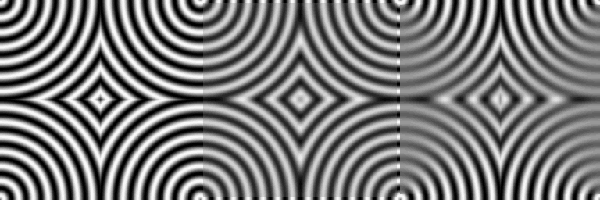The SMOOTH function returns a copy of Array smoothed with a boxcar average of the specified width. The result has the same type and dimensions as Array. The algorithm used by SMOOTH is:

where w is the smoothing width and N is the number of elements in A.
Examples
The following example smooths a dataset in two different ways.
data = SIN(DIST(256)/3)
im1 = image(data, LAYOUT=[3,1,1], DIMENSIONS=[768,400], MARGIN=0)
im2 = image(SMOOTH(data,9), LAYOUT=[3,1,2], /CURRENT, MARGIN=0)
im3 = image(SMOOTH(data,[1,15]), LAYOUT=[3,1,3], /CURRENT, MARGIN=0)

See Additional Examples for more information on using SMOOTH.
Syntax
Result = SMOOTH( Array, Width [, /EDGE_MIRROR]
[, /EDGE_TRUNCATE]
[, /EDGE_WRAP]
[, /EDGE_ZERO]
[, MISSING=value]
[, /NAN] )
Return Value
Returns the smoothed array, which has the same dimensions as the input array.
Arguments
Array
The array to be smoothed. Array can have any number of dimensions.
See Note on Smoothing Over Large Data Ranges if Array contains data from a very wide range of data values.
Width
The width of the smoothing window. Width can either be a scalar or a vector with length equal to the number of dimensions of Array. If Width is a scalar then the same width is applied for each dimension that has length greater than 1 (dimensions of length 1 are skipped). If Width is a vector, then each element of Width is used to specify the smoothing width for each dimension of Array. Values for Width must be smaller than the corresponding Array dimension. If a Width value is even, then Width+1 will be used instead. The value of Width does not affect the running time of SMOOTH to a great extent.
Note: A width value of zero or 1 implies no smoothing. However, if the NAN keyword is set, then any NaN values within the Array will be treated as missing data and will be replaced.
Tip: For a multi-dimensional array, set widths to 1 within the Width vector for dimensions that you do not want smoothed.
Keywords
Note: If none of the EDGE_* keywords are set, the end points are copied from the original array to the result with no smoothing.
Note: Normally, two-dimensional floating-point arrays are smoothed in one pass. If any of the EDGE_* keywords are specified for a two-dimensional floating-point array, the result is obtained in two passes, first for all of the rows, and second for all of the columns. Therefore, the results for points in the interior of the array may differ slightly when any of the EDGE_* keywords are set. This difference will be most pronounced if the array contains NaN values.
EDGE_MIRROR
Set this keyword to apply the smoothing function to all points. If the neighborhood around a point includes a point outside the array, a "mirrored" edge point is used to compute the smoothed result.
For example, when smoothing an n-element vector with a five-point-wide smoothing window, the second point of the result R0 is equal to A0 if no EDGE_* keywords are set, but is equal to (A1+A0+A0+A1+A2)/5 if the EDGE_MIRROR keyword is set. In the same manner, point Rn-1 is set to An-1 if no EDGE_* keywords are set, or to (An-3+An-2+An-1+An-1+An-2)/5 if EDGE_MIRROR is set.
EDGE_TRUNCATE
Set this keyword to apply the smoothing function to all points. If the neighborhood around a point includes a point outside the array, the nearest edge point is used to compute the smoothed result.
For example, when smoothing an n-element vector with a three-point-wide smoothing window, the first point of the result R0 is equal to A0 if no EDGE_* keywords are set, but is equal to (A0+A0+A1)/3 if the EDGE_TRUNCATE keyword is set. In the same manner, point Rn-1 is set to An-1 if no EDGE_* keywords are set, or to (An-2+An-1+An-1)/3 if EDGE_TRUNCATE is set.
EDGE_WRAP
Set this keyword to apply the smoothing function to all points. If the neighborhood around a point includes a point outside the array, a "wrapped" edge point is used to compute the smoothed result.
For example, when smoothing an n-element vector with a three-point-wide smoothing window, the first point of the result R0 is equal to A0 if no EDGE_* keywords are set, but is equal to (An-1+A0+A1)/3 if the EDGE_WRAP keyword is set. In the same manner, point Rn-1 is set to An-1 if no EDGE_* keywords are set, or to (An-2+An-1+A0)/3 if EDGE_WRAP is set.
EDGE_ZERO
Set this keyword to apply the smoothing function to all points. If the neighborhood around a point includes a point outside the array, a value of 0 is used to compute the smoothed result.
For example, when smoothing an n-element vector with a three-point-wide smoothing window, the first point of the result R0 is equal to A0 if no EDGE_* keywords are set, but is equal to (0+A0+A1)/3 if the EDGE_WRAP keyword is set. In the same manner, point Rn-1 is set to An-1 if no EDGE_* keywords are set, or to (An-2+An-1+0)/3 if EDGE_WRAP is set.
MISSING
The value to return for elements that contain no valid points within the kernel. The default is the IEEE floating-point value NaN. This keyword is only used if the NAN keyword is set.
NAN
Set this keyword to cause the routine to check for occurrences of the IEEE floating-point values NaN or Infinity in the input data. Elements with the value NaN or Infinity are treated as missing data. In the Result, missing elements are replaced by the smoothed value of all other valid points within the smoothing window. If all points within the window are missing, then the result at that point is given by the MISSING keyword.
Note: SMOOTH should never be called without the NAN keyword if the input array may possibly contain NaN values.
Note on Smoothing Over Large Data Ranges
The smallest resolvable difference between two double-precision numbers is about 1/1015. If your data include numbers that span a large range, such as 1 and 1015 or greater, numerical roundoff effects will degrade the accuracy of the computation.
For efficiency, SMOOTH computes a running total using the difference between neighboring values, and then divides by the smooth width. Because of this, if the input data contain data representing a range of values larger than 1015, the results may not appear symmetric following the large values. For example:
a = [1.0, 1.0, 2.0, 3.0, 4.0, 1d18, 4.0, 3.0, 2.0, 1.0, 1.0]
PRINT, SMOOTH(a, 3), FORMAT='(11(G0.3,:,", "))'
IDL Prints:
1, 1.33, 2, 3, 3.33E+017, 3.33E+017, 3.33E+017, 0, -1, -1.67, 1
A different way to compute the smoothed array is to use the SHIFT operation, which won’t pollute the downstream values. For example:
a = [1.0, 1.0, 2.0, 3.0, 4.0, 1d18, 4.0, 3.0, 2.0, 1.0, 1.0]
PRINT, (a+SHIFT(a,-1)+SHIFT(a,1))/3, FORMAT='(11(G0.3,:,", "))'
IDL Prints:
1, 1.33, 2, 3, 3.33E+017, 3.33E+017, 3.33E+017, 3, 2, 1.33, 1
This method has the same roundoff errors as using SMOOTH, and uses more memory, but does give symmetric results.
Additional Examples
The following example smooths an RGB image with the multidimensional width argument.
file = FILEPATH('rose.jpg', $
SUBDIRECTORY = ['examples', 'data'])
img = READ_IMAGE(file)
im1 = image(img, LAYOUT=[3,2,2], DIMENSIONS=[800,400])
im2 = image(SMOOTH(img,[1,1,21]), LAYOUT=[3,2,4], /CURRENT)
im3 = image(SMOOTH(img,[1,21,1]), LAYOUT=[3,2,5], /CURRENT)
im4 = image(SMOOTH(img,[1,5,5]), LAYOUT=[3,2,6], /CURRENT)

Version History
|
Original |
Introduced |
|
8.1 |
Added EDGE_MIRROR and EDGE_WRAP keywords
|
| 8.6.1 |
Added EDGE_ZERO keyword |
See Also
CONVOL, DIGITAL_FILTER, LEEFILT, MEDIAN, TS_DIFF, TS_FCAST, TS_SMOOTH